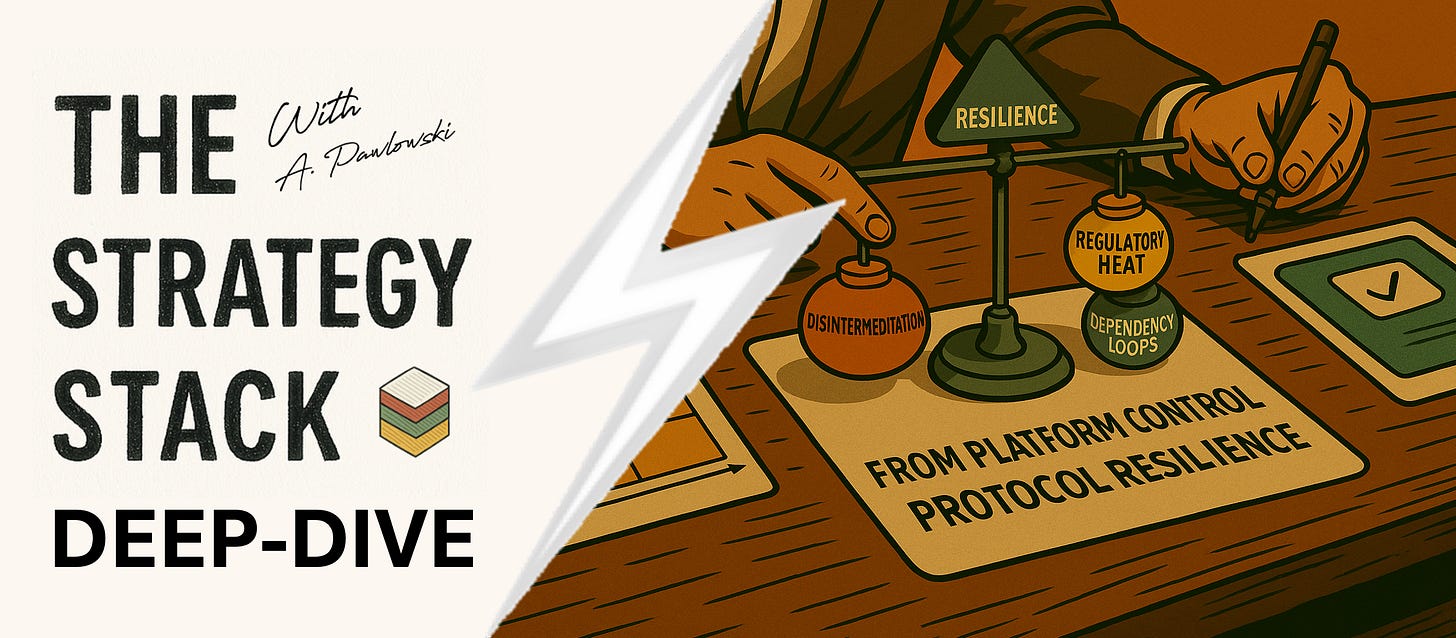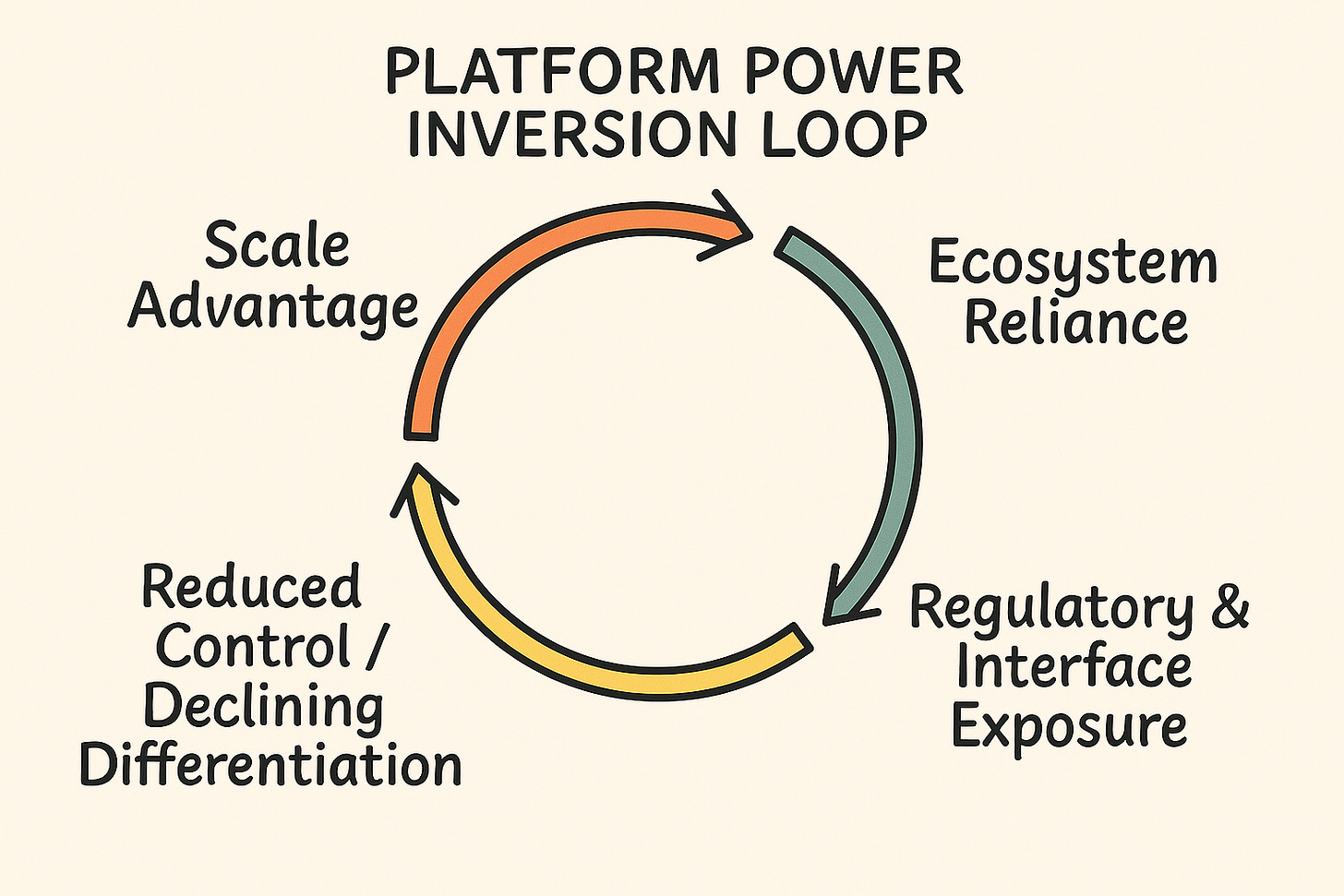Platform Risks in 2025: Governance, Data Sovereignty, and the Fragility of AI-Powered Platforms
124: 5.3 Platform Risks - Disintermediation, Regulatory Heat, Dependency Loops
If platform businesses create value through participation, AI-powered platforms now capture it through orchestration.
In the post-platform economy, the logic of power is shifting — from platform business models built on ecosystem participation to aggregator business models built on distribution strategy, compliance, and attention economics.
The new rule:
If platforms organize supply, aggregators orchestrate demand.
TL;DR: Platform Risk = Dependency Exposure × Governance Maturity
Winning aggregators and AI-powered platforms don’t own supply — they own access.
They dominate by controlling:
Interface — where users start
Data gravity — where feedback loops compound
Switching friction — where alternatives disappear
Aggregation power has migrated from web platforms → social feeds → AI assistants and chat-based interfaces.
The new chokepoints are invisible — embedded deep in APIs, models, and interface layers.
Table of Contents
The Paradox of Platform Power
Disintermediation: The End of Platform Stickiness
Regulatory Heat: The Cost of Dominance
Dependency Loops: The Invisible Fragility of Platforms
Strategic Guidance: Building Resilience in the Post-Platform Era
Closing Thought — From Platforms to Protocols of Trust
1. The Evolution of Aggregation: From Platforms to Interfaces
Aggregation Theory (Ben Thompson, 2015) originally explained how companies like Google, Facebook, and Netflix dominated: control the user relationship, commoditize suppliers, and capture margin from the middle.
But by 2025, platform business models have evolved:
Information → Inference
Search → Ask
Geography → Algorithm
Choice → Delegation
We no longer “browse” — we “prompt.”
Distribution isn’t geographic or even digital — it’s algorithmic.
Aggregation has migrated up the stack, from websites and app stores to model-layer orchestration — the interfaces that mediate attention through AI-powered platforms.
Empirical Anchor
According to BCG’s Interface Power Index (2025), six AI-powered platforms (OpenAI, Anthropic, Perplexity, Google, Amazon, ByteDance) now mediate ~70% of all consumer queries globally.
They don’t own the content — but they own the routes to it.
That’s the modern platform economics of the attention economy: whoever owns intent, owns the outcome.
For strategists, this marks the next phase of platform governance — control has migrated from supply chains to coordination systems that determine how data, access, and influence flow.
2. The Mechanics of Modern Aggregator Business Models
Aggregators dominate via self-reinforcing dynamics that mirror — but surpass — traditional platform business models.
Demand Capture
Whoever owns the interface owns intent — the foundation of modern distribution strategy.
In 2025, AI assistants and AI-powered platforms are the new browsers.
Supply Commoditization
Producers, data providers, and developers become interchangeable fuel for the aggregator’s demand engine.
The new economy of composable APIs and models means that creators and suppliers operate under the orchestration logic of composable platforms — modular systems that scale coordination rather than ownership.
Feedback Loops
Every interaction improves precision and deepens dependency — the essence of attention-economy flywheels.
These feedback loops create “attention monopolies” — not through contracts, but through context.
Modern Examples:
Perplexity AI aggregates answers, not pages. Every query refines retrieval precision.
TikTok aggregates discovery, not content. The recommendation graph is the new distribution layer.
OpenAI GPTs aggregate capability. Developers build value, but the interface retains power.
Each case reflects not just aggregation, but coordination — the management of dependencies and flows inside complex digital ecosystems.
Strategic Insight:
If you’re not the interface, be the infrastructure behind it.
Distribution strategy today means controlling flow, not market share.
Strategic Best Practice:
Identify where intent originates — that’s where aggregation begins.
If you’re not the interface, become the infrastructure feeding it.
Design your compliance strategy and platform governance around flow control, not ownership.
As AI-powered platforms mediate more of human interaction, resilience now depends on the ability to govern modularly — through composable platforms that isolate dependency risk.
3. Emerging Chokepoints in 2025
With aggregation comes oversight.
Platforms that once thrived on scale are now treated as critical infrastructure — and therefore heavily scrutinised.
Real Case Study: Google LLC — EU Ad-Tech Antitrust Fine
Aggregation is now semantic, not structural.
Power has shifted from traffic aggregation to meaning aggregation — controlling how inference and attention flow through AI-powered platforms.
Empirical Anchor
McKinsey’s AI Distribution Report 2025 reveals:
80% of new user sessions originate inside aggregated intent surfaces (AI copilots, chat interfaces, or embedded search).
Traditional discovery (web search, app stores, social feeds) is down 45% since 2022.
Implication:
The distribution frontier has collapsed inward — into model layers, APIs, and embedded assistants.
This is no longer platform strategy — it’s interface strategy guided by platform governance and data sovereignty concerns.
As models ingest more proprietary information, data sovereignty — who owns, stores, and controls data at the interface layer — becomes a central issue for compliance, resilience, and economic capture.
Figure — Regulatory Heat Index for Platforms
(Heatmap: Google, Meta, Amazon, ByteDance, OpenAI, Apple × Antitrust, AI Governance, Data Portability, Content Moderation, Competition Law)
The governance problem is now as architectural as it is legal.
Platform governance has become a discipline of its own — blending compliance, data ethics, and coordination design.
Keep reading with a 7-day free trial
Subscribe to The Strategy Stack to keep reading this post and get 7 days of free access to the full post archives.






